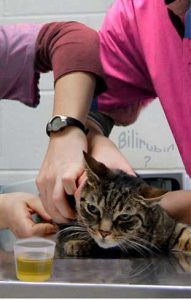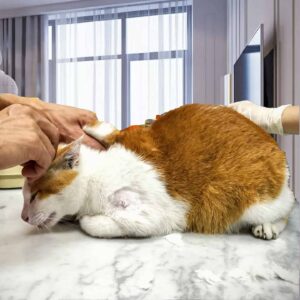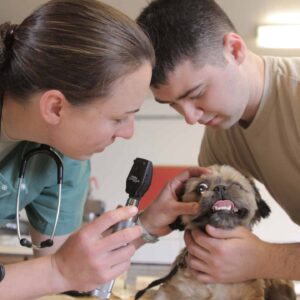Ron Hines DVM PhD
 A Science-Based Vaccination Schedule For Your Dog & Cat
A Science-Based Vaccination Schedule For Your Dog & Cat
I wrote this article some years ago. The links above give you more current information. If you are here, it’s quite likely that your veterinarian sent you a vaccination reminder postcard or a call – or that your dog or cat received a booster vaccination and things did not go well. Your cat or your dog require their initial two or three-shot kitten and puppy vaccination series – and a safety booster vaccination at one year of age to assure that they are well protected against the common infectious diseases they might be exposed to. The immunity that these vaccines impart is known to persist for a very long time – much longer than antibodies can be detected in its blood stream. (read here) After that initial, long-lasting immunity has formed, with every additional unnecessary vaccine booster, the likelihood of undesirable reactions increase. It might be true that the majority of adult dogs and cats will handle those unnecessary vaccinations well. But some will not. And when reactions do occur, they are frightening to pet owners, veterinarians and pets alike. The number of dogs and cats that experience those unwanted reactions is unknown. But it is considerably greater than what gets reported to the USDA or to the vaccine manufacturers. (read here)
Adjuvants are compounds that are added to vaccines in an attempt to increase their effectiveness. They are a wake-up call to your pet’s immune system. Besides adjuvants, many vaccines also contain preservatives, antimicrobials, stabilizers and other substances. Few veterinarians administer adjuvanted vaccines anymore because adjuvants appear to increase the likelihood of side effects. Most veterinary vaccines produced today advertise as being non-adjuvanted with a 3-year proven-immunity for your cat or your dog. Three exceptions are the vaccines against leptospirosis and Lyme disease in dogs and kennel cough in dogs and cats. That is not surprising, disease that one can catch more than once in a lifetime such as those rarely have long-lasting vaccines. Other vaccines, such as against calicivirus in cats do not give complete immunity but perhaps decrease the severity of an infection when it occurs. Vaccines don’t suddenly stop protecting your pet when 3 years have passed. It’s just that the pharmaceutical companies producing them never test for immunity past three years. It is not in their interest to do so and no one requires it. Even non-adjuvanted vaccines are not entirely risk-free. If your pet has had a prior vaccine reaction, a persistent or transient lump at the injection site, or its siblings or parents have had vaccine reactions, I would think seriously before agreeing to having more “booster” vaccinations administered. But should you elect periodic booster vaccinations for your pet, I would consider intranasal or oral vaccines the safer option.
Perhaps 4% of dogs have visible reactions subsequent to their booster vaccinations. The number in cats remains unknown. But many events occur subsequent to a vaccination that are not visible or immediate. (read here) The number of those unwanted reactions appear to be less in random-bred ordinary domestic cats and mixed-breed dogs due to their genetic diversity and better resistance to a wide range of diseases.

The occurrence of unwanted reactions becomes considerably higher when strains of leptospira are included in a canine vaccine. Unlike the weakened or inactivated virus and bacterial elements in other multipurpose dog and cat vaccines, the ones marketed against leptospirosis contain surface antigens that are highly antigenic and inflammatory in their own right. (read here & here) Rather than vaccinate small breeds or puppies under 5 months of age against leptospirosis, I just suggest you isolate them from the most common sources of infection, doggy parks, rats and stagnant water.

Reactions range from a day or two of reduced activity and food intake, to life-threatening situations that occur within as little as 20 – 30 seconds after the vaccine is given. The most serious of these are true anaphylactic reactions. Anaphylaxis is similar to a severe, sudden and violent allergy. It does not occur when a pet receives its first shot, but that vaccination can prime a pet’s immune system to react to a subsequent vaccination that shares one or more of the same ingredients. In my experience, the longer the interval between vaccination and reaction, the less severe the reaction is likely to be. The risk of vaccine reaction seems to decrease significantly as your pet’s body weight increases. Dogs weighing 22 – 99 pounds have approximately half the risk of vaccine reactions when compared with dogs weighing less than 22 pounds such as chihuahuas, toy poodles, dachshunds, pugs and terriers. Equal dose size for all – as mandated by the government – might partially account for that. (read here) The more vaccines administered during a single office visit, the more likely it is that reactions could occur.


However, when your pet is “not himself or herself” the following day or two after vaccination, it can be due to nothing more than the stress of the hospital visit. (read here) Some pets are considerably more emotional than others. They suffer real physiological distress due to the fear they experience in veterinary hospital settings. (read here) Fear-based reactions are most commonly in toy, herding and high-strung dog breeds. Shy, fearful cats often internalize their fears rather than putting up a fuss; nevertheless, fear influences how their body will react to various medications which probably includes vaccines as well. (read here) Soreness at the vaccination site is another common phenomenon – particularly when the vaccine contained a leptospirosis ingredient.


Utilizing an empathetic house call veterinarian is sometimes the best solution to these types of fear-based problems. The best way to locate one is through the recommendation of friends. Veterinary hospitals on wheels where vaccinations are administered onboard offer little more than client convenience. The same goes for vaccination jamborees.
If It’s A True Vaccine Reaction?
I personally advise that these dogs and cats receive no further booster vaccinations. I feel that the dangers of subsequent vaccinations reactions outweigh their benefits. Your pet’s immune system is trying to alert you to something important. But If you feel you must re-vaccinate your pet, consider requesting pre-treatment with antihistamines and corticosteroids. That does not guarantee that a reactions will not occur, but it is the best suggestion I can offer. Tranquilizers and sedatives might calm your pet. That can be helpful when your dog or cat’s reactions are solely or partially fear-based. But they have no effect on true vaccine reactions – all of which are immune system and antibody based. As I mentioned, subsequent reactions are often more severe than the previous one. Do not have more than one vaccine administered on the same day. Note the brand of vaccine that was used and do not use that brand again. Use a vaccine that contains no adjuvants. If it is marketed as a full milliliter or a half milliliter dose vaccine is irrelevant. In prior reaction pets, a house call veterinarian is not a good option. One wants a fully stocked hospital and substantial staff to deal with anaphylaxis if it occurs. Many veterinarians still recommend that dogs and cats receive vaccinations much too frequently. But do remember that properly timed kittenhood and puppyhood vaccinations and a booster at one year in healthy pets are very important to your cat and dog’s long-term wellbeing.
What About Rabies Vaccinations?
This is both a legal issue and a health issue. In 2021, there were five cases of human rabies in the United States, the highest in ten years. Although only three days are left in 2022 as I write this, the CDC has not yet announced how many cases occurred this year. Last year, four were due to direct exposure to rabid bats. The one person who contracted rabies from a dog had been bitten in the Philippines. In 2019 and 2020, no rabies deaths occurred in the United States. However, if there was no legal requirement to immunize your pets against rabies, undoubtedly the number of people exposed to rabies would substantially increase. Some states require a rabies vaccination every year, others every three years. Many proven three-year vaccines are on the market. How you handle this issues is a decision you must make for yourself. A pet that roams freely out of doors, captures prey wildlife or that is likely to bite is much more at risk of contracting rabies or causing human concerns than one that is not. In some principalities, a letter from your veterinarian explaining the danger of immunizations or a current rabies antibody titer from your pet might suffice. You will need to determine if this is the case where you live.
You are on the Vetspace animal health website
Visiting the products that you see displayed on this website help pay the cost of keeping these articles on the Internet.





